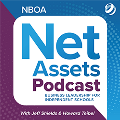
NBOA President and CEO
Becoming more “data-driven” has been a mantra at schools for the last several years. We have mountains of data and ample opportunities to benchmark against similar institutions. But is this too much of a good thing? I frequently hear business officers say, “I’m drowning in data.”
One of the prevailing issues is knowing how to bring data into leadership discussions. As I travel the country and speak with heads of schools and business officers, I find the desire for accessible data to inform financial decisions is omnipresent. I would posit, however, that more data is not always better. Taking that one step further, more data without context and analysis is NEVER better. If benchmarking was the key to making informed financial decisions, our work would be done — independent school culture has never suffered a shortage of benchmarking.
If we are truly seeking an opportunity for data to not just help us compare school performance, but inform our work, we need to seek different solutions and present them in a manner digestible to our colleagues and trustees.
To this point, Harvard Business Review recently ran an article, “Companies Are Failing in Their Efforts To Become Data-Driven,” which outlines how organizations often fail to create a culture that readily and routinely uses data to inform strategic decision-making. The piece cited a 2019 AI executive survey, which found that among top leaders:
- 72% have yet to forge a data culture.
- 69% have not created a data-driven organization.
- 53% are not yet treating data as a business asset.
Given the incessant drumbeat of data’s importance, these statistics are troubling, and I would conjecture similar outcomes may be found in our schools. If we are truly seeking an opportunity for data to not just help us compare school performance, but inform our work, we need to seek different solutions and present them in a manner digestible to our colleagues and trustees. Three tools for strategically communicating data come to mind.
Last year, NBOA published “Key Financial Indicators of Vitality for Independent Schools,” an ideal launchpad for school leaders and trustees to begin productive discussions about a school’s financial health. Drawing on 2015–2017 trend data from the largest schools in NBOA's Business Intelligence for Independent Schools (BIIS) data collection platform, the report explores five indicators of financial sustainability and the data points behind them. Case studies provide insights into four high-performing schools that used the indicators to develop strategic positions in their markets. Stakeholders need to understand what they’re facing before they can agree to a course of action.
Other schools may be further along their data-driven journey. The NBOA Financial Dashboard for Independent Schools was developed to help business officers, heads of schools and boards of trustees among others identify, understand and monitor a broader set of financial indicators that impact an independent school's financial health. Available for the first time during the 2019-20 data collection period, the dashboard is now automatically generated as a report and integrated with customized benchmarking, for any school that submits a complete data set to BIIS. The dashboard’s comprehensive view can help school leaders assess strengths and weaknesses in key areas of school operations.

For schools that are ready to take data-driven decision-making to the next level and “get under the hood” of their school’s financial performance, the Composite Financial Index (CFI) Calculator is NBOA’s most sophisticated tool, designed to help leaders think strategically and communicate succinctly. Employed by higher education institutions for decades, the CFI produces a complete picture of your institution's financial strengths and weaknesses in a single score.
One of the amazing characteristics of our community is the uniqueness of each and every independent school. Forging a financially sustainable path forward will likely mirror the independence and specific circumstances our schools. Understanding where you are in using data and where you would like data to take you along this journey is an important first step.

Follow NBOA President and CEO Jeff Shields @shieldsNBOA.
Download a PDF of this article.


